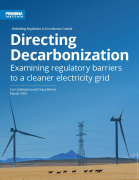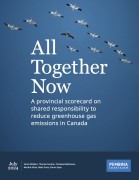Worldwide, an increasing number of countries, utilities and financial institutions are putting coal in the rear-view mirror. They are driven by climate action, the demand for cleaner air and the poor economics of coal. While the health impacts of air pollution and the greenhouse gas (GHG) emissions from coal are far higher than any other power source, there are readily available, abundant, cost-effective alternatives to coal-fired generation. This makes coal-fired electricity both uniquely harmful and unnecessary. The phase-out of coal is also happening in the context of countries committing to a net-zero economy by 2050, which would require a net-zero electricity grid by 2035 in developed countries.
The structural transition away from coal power generation is most advanced in economies that are part of the Organization for Economic Cooperation and Development (OECD), where power plants have tended to be older, electricity demand is often relatively flat compared to developing economies, and climate policies or carbon pricing have been introduced. The lessons learned from this experience will need to be proactively shared internationally, particularly as non-OECD countries complete their pivot away from adding new coal power capacity and begin planning their own phase-out pathways. The energy crunch experienced in China, India, Europe and elsewhere in October 2021 reinforces that policy-makers will need to develop approaches that are both robust in the face of potential short-term imbalances in supply and demand, and capable of providing a longer-term framework that can consistently drive investment in clean generation.
From Coal to Clean focuses on Canada's progress in phasing out coal since the height of coal-fired power in Canada at the turn of the century — through the pioneering Ontario coal phase-out completed in 2014 and the 2030 phase-outs announced in 2015 and 2016 — and up to the dramatically accelerated Alberta phase-out that will see coal power eliminated in that province by the end of 2023, nearly 40 years ahead of the schedule in place at the start of 2015. It also takes stock of the current plans in the remaining three coal-burning provinces, acknowledges recent progress in policies and plans, and identifies opportunities for improvement. It shows that, with the exception of New Brunswick, Canada is on track to phasing out coal by 2030.
Canada’s progress so far
- While Canada’s progress on coal phase-out started slowly in the early 2010s, Ontario’s pioneering action laid a marker for the world as the single largest climate measure of its time in North America.
- The 40-year acceleration of the coal phase-out in Alberta (from an original forecast of 2061 to the current 2023), demonstrates the power of coal phase-out commitments and effective carbon pricing design.
Opportunities to accelerate Canada’s phase-out
- Saskatchewan is already taking advantage of its strong portfolio of lower-emitting generation to achieve reductions in advance of its 2030 phase-out and has opportunities remaining to accelerate and deepen its progress.
- Nova Scotia — after initially insisting that coal must be in use beyond 2030, and receiving such exemption from the federal government — has accepted the feasibility of the 2030 phase-out and must now lock in its implementation plan.
- New Brunswick is pursuing leeway to continue using coal well past 2030, which would single the province out as a clear laggard on coal emissions and undermine Canada’s global leadership in phasing out coal.
To build toward a net-zero grid
To build towards a net-zero grid by 2035, provinces should replace coal with non-emitting generation options instead of new unabated gas-fired generation, to avoid losing about half of the GHG reductions from coal phase out.
Necessary provincial, federal government actions
To support the rapid, complete transition of Canada’s grid from coal to clean, the following actions are needed:
- The federal and provincial governments should set clear targets for a net-zero grid by 2035.
- Provinces should transition to effective sector-wide carbon pricing benchmarks.
- The federal government should develop more stringent protocols for protecting federal coal regulations against weakening via equivalency agreements.
- The federal government should support provincial investment in infrastructure and modernization of regulations to facilitate the integration of non-emitting electricity.
- We need greater data transparency and accessibility to accurately understand and project the impact of policies on electricity emissions.
- All levels of government, industry, and the financial sector should implement meaningful measures for an equitable transition.
Utility report
 Also read the companion piece, Progress from Coal to Clean, which charts the progress made by utilities in Canada’s four remaining coal-burning provinces. Progress from Coal to Clean explains in detail the indicators used to evaluate utility transition approaches, provides data collection methodology, and presents a narrative of the differing approaches utilities are taking to complete this energy transition.
Also read the companion piece, Progress from Coal to Clean, which charts the progress made by utilities in Canada’s four remaining coal-burning provinces. Progress from Coal to Clean explains in detail the indicators used to evaluate utility transition approaches, provides data collection methodology, and presents a narrative of the differing approaches utilities are taking to complete this energy transition.







